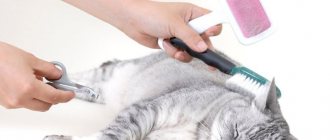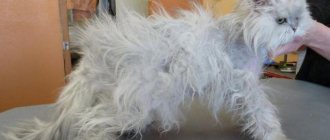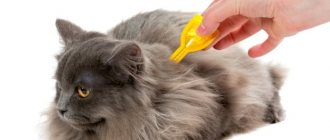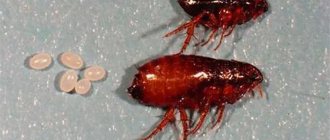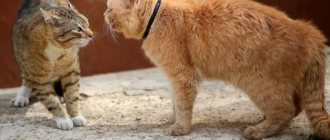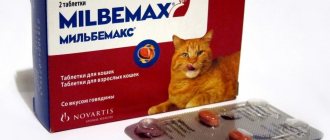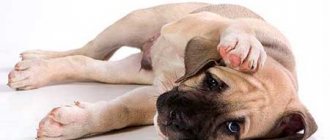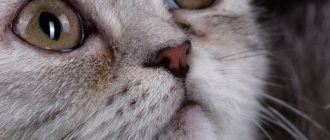A cat's fur is one of the indicators of its health and proper maintenance. The beautiful, smooth, shiny coat of a pet is the pride of the owner, especially if it participates in exhibitions.
The appearance of mats (matted dense balls of hair) indicates insufficient daily care or other problems for the pet. More often, cats of long-haired breeds (Persian, Maine Coon, Neva Masquerade, Turkish Angora, Siberian, Burmese, Norwegian Forest) suffer from this, since these animals cannot fully care for their thick and long hair. In cats of short-haired breeds, tangles can appear when sticky or adhesive substances come into contact with the fur: resin, varnish, paint, etc.
What are mats?
The fur of cats, especially long-haired breeds, requires careful care. With a lack of hygiene, poor nutrition and other mistakes when keeping pets, their fur begins to deteriorate. This affects not only appearance, but also health.
Older pets cannot provide themselves with the same careful care as younger pets. The wool begins to get tangled, matted, and tangles form. However, young age is not a guarantee that lumps will not appear.
What is it: how to recognize pellets?
In the coat of cats, a regeneration process is constantly taking place; the coat has the ability to renew itself and get rid of old hairs, which must be urgently removed by combing. If this is not done, the fallen hairs become entangled with the growing ones, tangles appear that are almost impossible to comb out, since such a procedure will cause severe physical pain to the pet. In this case, the pet’s owners will have no choice but to cut out the matted fur. As a rule, matting of pile with the formation of dense clumps in long-haired cats is observed in the neck, “pants”, tail, but can often be found on the back, stomach and the entire body of the animal.
A short-haired cat is much less likely to experience pellets in its fur. But if the pet is not provided with normal care, the cat is not bathed, its coat becomes dirty in the same way, the hair rolls off, tangles appear, which are no easier to remove than in the Persian.
Causes
If pets are healthy and can take care of their hygiene, they usually do not develop tangles. However, there are cat breeds with fluffy fur and thick undercoat that are prone to ball formation. These include Persians, British, Turkish Angora and others.
Not all long-haired breeds suffer from mats. For example, Siberian cats and Maine Coons rarely develop lumps. Mainly in places of thick and wavy undercoat (on the “collar”, “pants”).
Mats on wool appear for the following reasons:
- the pet is rarely or not brushed at all;
- during the molting period, the animal’s old fur is not combed out;
- the pet is sick;
- the cat is washed with an incorrectly selected shampoo; when soaping, the fur becomes very crumpled, which is why dense clumps are formed;
- the cat is lazy and fat, obese;
- the pet does not eat rationally, which is why it may develop vitamin deficiency (the fur becomes very loose and the risk of lumps forming increases);
- sticky substances (for example, jam, honey, paint, etc.) have come into contact with the fur;
- pathological conditions develop: oncology, parasites, dermatitis, endocrine disorders.
If a pet develops tangles, the owner is to blame. This means he did not take good care of the animal.
Can mats harm an animal?
Owners often underestimate the problem, not realizing that mats in cats can cause serious consequences:
- matted hair causes pain in the cat. The animal, trying to get rid of the problem, becomes nervous and irritable, worries, eats and sleeps poorly. This negatively affects the general condition of the pet;
- the undercoat falls tightly and close to the skin, so natural ventilation is disrupted. Because of this, heat exchange changes and in warm weather the animal may suffer from overheating, and in cold weather it may freeze, since the wool knocked into balls provides almost no warmth;
- constant companions of tangles are skin diseases in the form of eczema and dermatitis. Severe forms of these diseases can lead to the death of the pet.
Regardless of the number and size of tangles, this process cannot be ignored. Tangled areas of fur must be removed and this must be done correctly.
Why are they dangerous?
The appearance of matted fur spoils the appearance of the animal. This is a huge disadvantage for a breeder of purebred cats. In addition, petting a pet with mats is unpleasant.
However, these are not the worst consequences. Mats can provoke the development of various diseases. Pathogenic microorganisms begin to multiply in matted wool. When a pet licks itself, they enter the body and continue their synthesis there.
Fleas, lice, ticks and other parasites take root well in tangles. The skin under the lumps becomes rotten, dermatological problems arise that are difficult to treat. In addition, the cat will try to independently remove matted fur with its claws, and in the process may cause wounds to itself. Such damage will take a long time to heal.
What is the danger of mats?
Firstly, such a cat does not look very aesthetically pleasing. The whole feature of long-haired beauties is their rich hair. If you don’t have time for proper care, then you can think about whether it’s worth getting a pet of this breed.
Secondly, hairballs can damage your pet's skin. They do not provide normal ventilation and contribute to the appearance of dermatitis.
Thirdly, mats are not only unkempt and unsightly, they are a breeding ground for bacteria, infections and fleas.
Removal methods
Tangles are removed from wool in the following ways:
- If the lumps are small, you can comb them out. The pet should be placed on its side and stroked. This is necessary so that he calms down and does not break out. First, comb the sides and back, neck and chest, forelimbs, tail. It is more difficult to get rid of tangles on the stomach and hind legs. Most likely the animal will bite.
- Large clumps are recommended to be cut lengthwise and then combed.
- If there are a lot of tangles, it is completely impossible to comb them out, then the tangled hair will have to be cut to the ground. You need to be very careful: a cat’s skin is thin and can be easily damaged. Clumps can be removed with scissors, people clippers or hair clippers. The receding hairline will heal after a few months.
- At the pet store you can purchase a special device called a tangle cutter. This is a comb with blunt ends, blades between the teeth.
- You can take your cat to a veterinarian or pet groomer. There your pet will be trimmed at an affordable cost.
- To deal with long unnecessary hair, there is a special comb - a furminator. Not only will it help get rid of clumps, but it will also be an indispensable tool for daily combing.
Basic information about tangles
A mat is a dense lump formed from old felted wool. Young, healthy animals spend enough time on hygiene, licking themselves regularly and for a long time. In this way, they remove dead, fallen hairs, so that tangles do not appear.
Elderly and sick cats usually do not have enough strength to properly care for their fur coat.
For this reason, their fur intertwines, gets tangled and forms dense clumps. But sometimes even young individuals fail to prevent the formation of tangles. What are the reasons for such negative changes?
Rules for removing mats in cats
Recommendations for removing mats:
- The process of eliminating lumps is long. Most likely, your pet will not like it. The pet will not give in and will start fighting. Therefore, it is better to comb out tangles together: one person holds the cat, the other combs it. If the animal is very nervous, then it is better not to traumatize its psyche and get rid of the matted fur not at once, but several times.
- Only areas with long hair are clipped. It is better not to touch the paws and head. It's okay if your pet looks like a lion. The fur will grow back in a couple of months.
- Until the mats are removed, washing the animal is prohibited. After water, lumps are more difficult to comb out.
- After combing, treat the pet's fur with an antistatic spray. The product will detangle your hair and prevent further formation of tangles.
How to prevent tangles from appearing in your fur
The secret to preventive measures lies in proper care. Your cat's long coat should be brushed two to three times a week, paying special attention to hard-to-reach areas. When bathing an animal, it is better to use a special shampoo designed for washing long hair and undercoat.
Particular attention should be paid to preventing the appearance of fleas and ticks and promptly ridding your cat of them. You also need to monitor the animal’s nutrition, choosing food that is balanced in vitamins and minerals.
By following these simple rules, you can enjoy being with a beautiful and healthy pet for many years.
A balanced diet is the key to proper coat growth
Cats are predators, albeit small ones.
They need a certain amount of animal protein every day. Protein is the main source of energy necessary for both the active movement of the pet and the improvement of the coat.
The diet should contain vitamin A and arachidonic acid, without which the hairs become fragile and the hair loses its elasticity and shine.
A deficiency of microelements leads to a malfunction of organs and systems and causes the formation of tangles.
It is difficult to choose a balanced diet for a pet using products from the owner’s table.
In order for the fur to grow normally, be healthy and not roll into shreds, the cat must eat special food, the choice of which must take into account the animal’s age and status - for kittens or adult pets, pregnant and lactating.
For cats over 7 years of age, it is advisable to find a food formulated for older animals.
How to help your furry pet
Mats are not classified as a disease. But they can become not only a consequence of stress, but also its cause.
The more pellets there are on a cat’s body, the more difficult it is for her to get rid of them on her own. The owner must take care of the condition of the cover.
We save from tangles
| Methods | Peculiarities |
| Combing | It must be regular. The longer the hair, the more often the procedure is performed. To do this, you will need a special brush or combing glove or a comb with mild, wide-toothed teeth. |
| Unraveling | Fresh clumps of wool can be sorted out by hand by carefully separating the hairs. Then the animal is combed, paying special attention to problem areas. |
| Cutting | It is better to deal with neglected tangles with scissors. To begin with, you will have to separate the clump with your hands so as not to injure your pet’s skin. The procedure is completed by combing out |
| Colt cutter | This device, which is a hybrid of scissors and a comb, helps speed up the procedure and makes it safer |
When the owner’s efforts do not produce a positive result, it is recommended to contact specialists involved in grooming animals. In the salon, in addition to a haircut, your pet will also be provided with other services (they will tidy up their claws and treat their skin).
